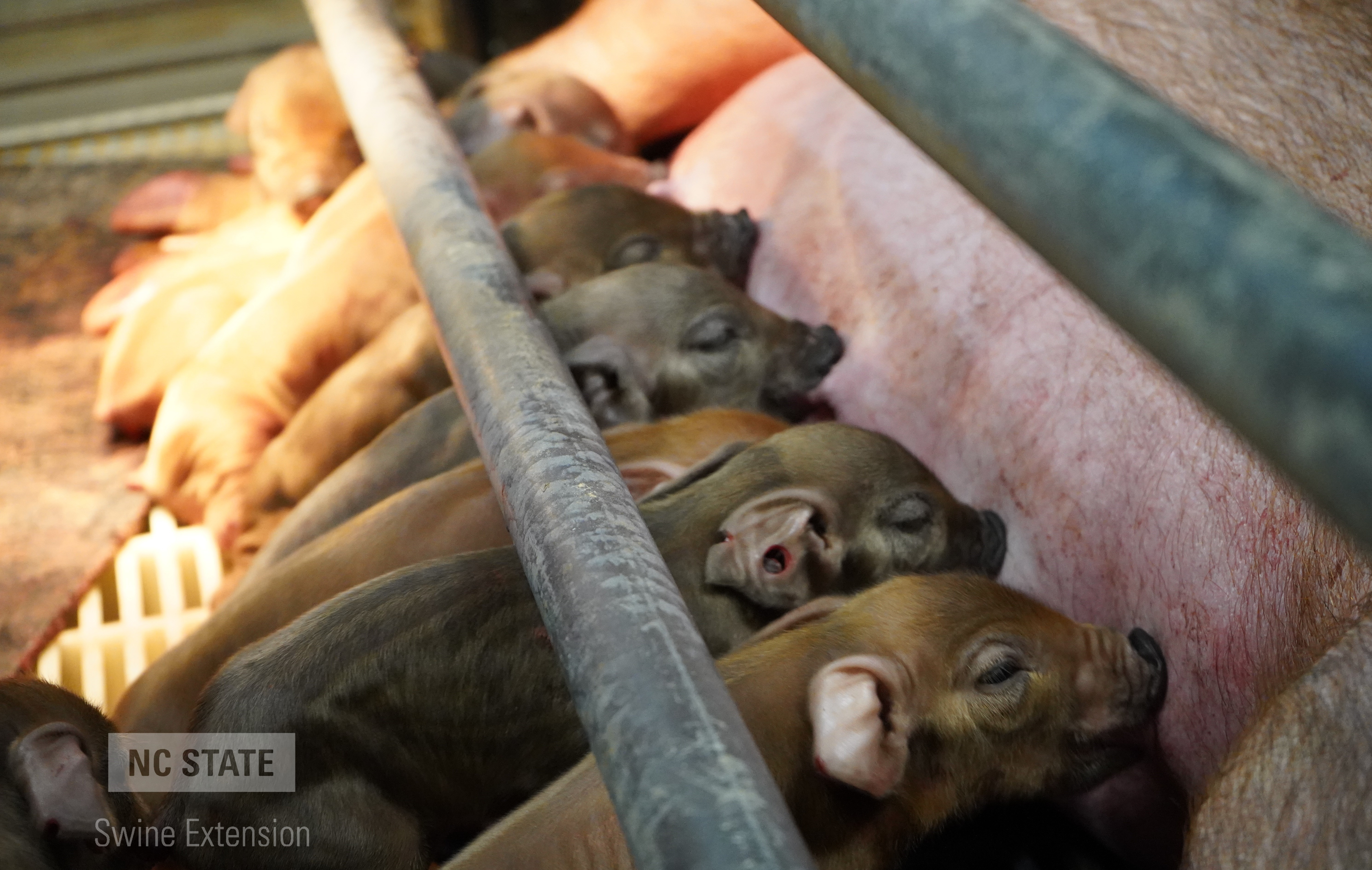When evaluating different farrowing crates, generally each design or size should be represented within the same room. To further complicate things, research for piglet survival requires hundreds of replicates per treatment to achieve adequate statistical power.
Farrowing crate width
Farrowing crate width has not been shown to greatly impact piglet survival in large commercial studies. Ketchem and Rix (2013) evaluated three farrowing crate types where the sow area was similar in length, yet some differences existed in width. In general, farrowing crate widths of 17 and 20 inches did not appear to greatly impact piglet survival. Keeping the sow area the same, Vande Pol (2017) evaluated farrowing crate width using over 1,600 litters. The author reported no statistical differences for preweaning mortality between farrowing crate widths of 60 and 66 inches (15.2% vs. 14.6%, respectively).
Farrowing crate length
There is anecdotal evidence that farrowing crate length impacts piglet survival, perhaps more so for longer, heavier sows. We recently analyzed data from a commercial sow farm in eastern North Carolina with which we collaborate. The farm expanded in size over time and has three different farrowing crate sizes (Table 1).

Table 1: Dimensions of three farrowing crates used on one commercial farm in eastern North Carolina.
Only 670 sows are included in the dataset. Therefore, the data provides good anecdotal evidence but perhaps not a sufficient number of observations to make major decisions. Managers of the farm were confident they weaned fewer piglets in a certain area of the farm. Our data helps validate their inclination.
Figure 1 shows piglet survival (number weaned divided by [stillborn plus number born alive]) across the three types of farrowing crates. Combining the information from Table 1 and Figure 1, it appears sows in the longer farrowing crates (types B and C) had better piglet survival than sows in the shorter farrowing crate (A).

Figure 1: Piglet survival (n=670 sows) across three different farrowing crate sizes at a commercial farm in eastern North Carolina. Length of sow area for farrowing crate types A, B and C were 78, 84 and 83.25 inches, respectively. Average litter size for the data set was 13.9 piglets.
Longer sows wean fewer piglets?
While interactions between farrowing crate length with sow length and sow weight remain to be validated, evidence of sows being too long comes from a 2009 Pork Checkoff study. The study scored gilts for body length 1 (short) to 9 (long) at selection and followed the gilts through multiple parities. Piglet survival (extrapolated) for sows by body length is shown in Figure 2. Gilts that were longer at selection subsequently had reduced piglet survival as sows.

Figure 2: Piglet survival (extrapolated) for sows by body length (1=short; 9=long) at gilt selection. Gilts were followed through multiple parities. Reported farrowing crate length was 90 inches.
Heavier sows wean fewer piglets
Observational data from commercial production systems suggest heavier sows wean fewer piglets (Figure 3). In agreement, Wülbers-Mindermann et al. (2002) and Munhoz Morello (2015) reported heavier sows had greater piglet mortality. Generally, commercial farms do not weigh sows. Yet they may commonly see greater piglet mortality in higher parity sows. Some or much of the increased piglet mortality in higher parity sows can be attributed to sow weight.

Figure 3: Impact of sow weight at breeding on subsequent number of piglets weaned on a commercial farm in eastern North Carolina. Each circle represents a sow. The regression line indicates a 100-pound increase in sow weight at breeding reduced number of piglets weaned by 0.37 piglets (Bryan, 2014).
How do I keep my sows from becoming too big for my farrowing crates?
There are multiple strategies that can be utilized to prevent large sows. Please refer to past articles addressing strategies to reduce sow size through genetics, managing gilt weight at breeding and body condition management.
Going forward
Perhaps the data presented in this article suggest more research is needed to determine optimal farrowing crate size in relation to reproductive throughput. Questions or comments can be sent to Mark Knauer.
References
Bryan, M. 2014. Associations among body condition, reproductive performance and body lesions in group housed sows. MS Thesis. North Carolina State Univ., Raleigh.
Ketchem, R., and M. Rix. 2013. Is Farrowing Crate Design a Constraint to Weaning Average? National Hog Farmer Online.
Knauer, M. 2017. Reducing sow feed cost — gilt size matters. National Hog Farmer Online.
Knauer, M. 2017. Genetic strategies to reduce gilt feed and development costs. National Hog Farmer Online.
Knauer, M. 2017. The sow body condition caliper, a paradigm change in sow management. National Hog Farmer Online.
Munhoz Morello, G. 2015. Investigating piglet crushing by the sow: A data mining approach. PhD Dissertation, Purdue Univ., West Lafayette.
Stalder, K.J. 2009. Association of compositional traits and structural soundness with the ability of commercial line of sows to complete parities two and three — NPB#06-031. National Pork Board Report.
Vande Pol, K. 2017. The impact of sow gestation housing system (individual vs. group) on the reproductive performance of sows across six parities and the effect of farrowing pen size on pre-weaning mortality. MS Thesis. Univ. of Illinois, Champaign.
Wülbers-Mindermann, M., B. Algers, C. Berg, N. Lundeheim and J. Sigvardsson. 2002. Primiparous and multiparous maternal ability in sows in relation to indoor and outdoor farrowing systems. Livest. Prod. Sci., 73: 285-297.



